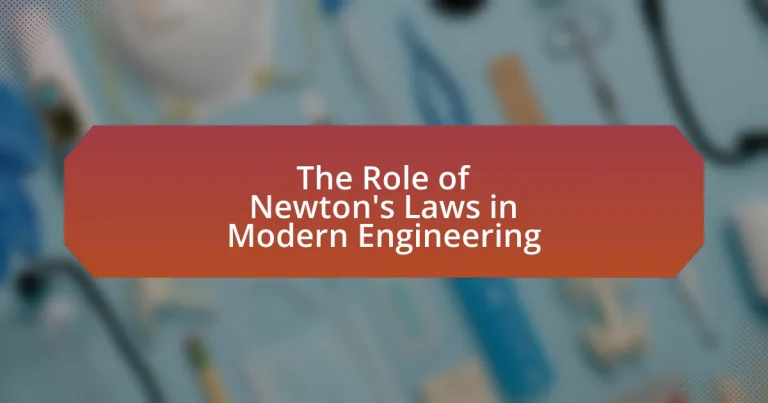Newton’s Laws of Motion are three fundamental principles that describe the relationship between the motion of an object and the forces acting upon it. These laws—namely the law of inertia, the law of acceleration, and the law of action-reaction—are critical in engineering disciplines such as mechanical, civil, and aerospace engineering. They provide the foundational framework for analyzing and predicting the behavior of structures and mechanical systems, influencing design, safety, and efficiency. The article explores how these laws apply to modern engineering practices, their significance in structural analysis, and the challenges engineers face when applying them in complex systems. Additionally, it addresses common misconceptions and best practices for effectively utilizing Newton’s Laws in engineering work.
What are Newton’s Laws and their significance in engineering?
Newton’s Laws consist of three fundamental principles that describe the relationship between the motion of an object and the forces acting upon it. The first law, the law of inertia, states that an object at rest stays at rest, and an object in motion stays in motion unless acted upon by a net external force. The second law establishes that the acceleration of an object is directly proportional to the net force acting on it and inversely proportional to its mass, expressed mathematically as F=ma. The third law states that for every action, there is an equal and opposite reaction.
In engineering, these laws are significant as they form the foundation for analyzing and predicting the behavior of structures and mechanical systems. For instance, the application of the second law is crucial in designing vehicles, where engineers calculate forces to ensure safety and performance. The first law is essential in understanding stability in structures, while the third law is fundamental in propulsion systems, such as rockets, where the action of expelling gas results in the reaction of forward motion. These principles enable engineers to create efficient, safe, and reliable designs across various fields, including aerospace, civil, and mechanical engineering.
How do Newton’s Laws apply to modern engineering practices?
Newton’s Laws of Motion are fundamental principles that underpin modern engineering practices, guiding the design and analysis of structures, vehicles, and machinery. The first law, the law of inertia, informs engineers about the behavior of objects at rest and in motion, allowing for accurate predictions of how structures will respond to forces. The second law, which states that force equals mass times acceleration, is crucial for calculating loads and stresses in materials, ensuring safety and efficiency in design. The third law, which asserts that for every action there is an equal and opposite reaction, is essential in understanding interactions between components, such as in propulsion systems and structural supports. These laws are applied in various fields, including aerospace engineering, where they help in the design of aircraft and spacecraft, and civil engineering, where they guide the construction of buildings and bridges to withstand environmental forces.
What are the three laws formulated by Newton?
The three laws formulated by Newton are known as Newton’s First Law, Second Law, and Third Law of Motion. Newton’s First Law states that an object at rest stays at rest, and an object in motion continues in motion with the same speed and in the same direction unless acted upon by a net external force. The Second Law establishes that the acceleration of an object is directly proportional to the net force acting on it and inversely proportional to its mass, expressed mathematically as F=ma. The Third Law asserts that for every action, there is an equal and opposite reaction. These laws are foundational in classical mechanics and are critical for understanding motion and forces in engineering applications.
How do these laws influence engineering design and analysis?
Newton’s laws significantly influence engineering design and analysis by providing foundational principles that govern motion and forces. These laws enable engineers to predict how objects will behave under various conditions, which is essential for designing safe and efficient structures and systems. For instance, Newton’s second law, which states that force equals mass times acceleration, allows engineers to calculate the forces acting on structures, ensuring they can withstand loads without failure. Additionally, Newton’s third law, which asserts that for every action there is an equal and opposite reaction, is crucial in analyzing systems like rockets and vehicles, where thrust and propulsion are involved. The application of these laws is evident in fields such as aerospace, civil, and mechanical engineering, where precise calculations based on Newtonian mechanics lead to successful project outcomes.
Why are Newton’s Laws foundational to engineering disciplines?
Newton’s Laws are foundational to engineering disciplines because they provide the fundamental principles governing motion and forces, which are essential for analyzing and designing structures, machines, and systems. These laws, specifically the law of inertia, the law of acceleration, and the law of action-reaction, allow engineers to predict how objects will behave under various forces, enabling accurate calculations in fields such as mechanical, civil, and aerospace engineering. For instance, the application of these laws is critical in determining load distributions in bridges or the dynamics of vehicles, ensuring safety and functionality in engineering designs.
Which engineering fields rely heavily on Newton’s Laws?
Mechanical engineering, aerospace engineering, and civil engineering rely heavily on Newton’s Laws. Mechanical engineering applies these laws to analyze forces and motion in machinery and structures, ensuring they operate efficiently and safely. Aerospace engineering utilizes Newton’s Laws to design and optimize aircraft and spacecraft, focusing on propulsion and aerodynamics. Civil engineering employs these principles to assess loads and stresses in buildings and bridges, ensuring structural integrity and safety. The reliance on Newton’s Laws in these fields is foundational, as they govern the behavior of physical systems under various forces and conditions.
How do Newton’s Laws enhance safety and efficiency in engineering?
Newton’s Laws enhance safety and efficiency in engineering by providing fundamental principles that govern motion and forces, allowing engineers to predict and analyze the behavior of structures and systems. For instance, Newton’s First Law, the law of inertia, ensures that engineers design structures that can withstand external forces without collapsing, thereby enhancing safety. Newton’s Second Law, which relates force, mass, and acceleration, enables engineers to calculate the necessary forces required for machinery and vehicles, optimizing performance and efficiency. Newton’s Third Law, stating that for every action there is an equal and opposite reaction, is crucial in understanding interactions between components, ensuring that systems operate smoothly and safely. These laws are foundational in fields such as aerospace, civil, and mechanical engineering, where precise calculations based on these principles lead to safer and more efficient designs.
How do Newton’s Laws impact specific engineering applications?
Newton’s Laws significantly impact engineering applications by providing foundational principles for analyzing motion and forces in various systems. For instance, Newton’s First Law, the law of inertia, is crucial in automotive engineering, where it helps in designing safety features like seatbelts and airbags that protect passengers during sudden stops. Newton’s Second Law, which relates force, mass, and acceleration, is essential in structural engineering, allowing engineers to calculate loads and stresses on materials to ensure stability and safety in buildings and bridges. Newton’s Third Law, stating that for every action there is an equal and opposite reaction, is fundamental in aerospace engineering, influencing the design of propulsion systems in rockets and aircraft, where thrust must counteract gravitational forces. These laws are validated through extensive empirical research and practical applications, demonstrating their critical role in ensuring the safety, efficiency, and functionality of engineered systems.
What role do Newton’s Laws play in mechanical engineering?
Newton’s Laws are fundamental to mechanical engineering as they provide the foundational principles governing motion and forces. These laws enable engineers to analyze and predict the behavior of objects under various forces, which is essential for designing structures, machines, and systems. For instance, Newton’s First Law, the law of inertia, helps engineers understand how objects remain at rest or in uniform motion unless acted upon by an external force, which is critical in static and dynamic analysis. Newton’s Second Law, which relates force, mass, and acceleration, allows for the calculation of forces required to achieve desired accelerations in mechanical systems, directly influencing design specifications. Lastly, Newton’s Third Law, stating that for every action there is an equal and opposite reaction, is crucial in understanding interactions between components, such as in propulsion systems and structural supports. These principles are not only theoretical but are applied in real-world scenarios, such as in the design of vehicles, bridges, and machinery, ensuring safety and functionality.
How do these laws govern the motion of machines and structures?
Newton’s laws govern the motion of machines and structures by providing fundamental principles that describe how forces affect the movement of objects. The first law, the law of inertia, states that an object at rest will remain at rest, and an object in motion will continue in motion unless acted upon by a net external force, which is crucial for understanding static and dynamic equilibrium in structures. The second law quantifies the relationship between force, mass, and acceleration (F=ma), allowing engineers to calculate the forces required to achieve desired movements in machines. The third law states that for every action, there is an equal and opposite reaction, which is essential for analyzing interactions between components in mechanical systems. These laws are validated through extensive applications in engineering, such as the design of bridges, where the forces acting on the structure must be balanced to ensure stability and safety.
What are examples of mechanical systems that utilize Newton’s Laws?
Examples of mechanical systems that utilize Newton’s Laws include vehicles, cranes, and roller coasters. Vehicles, such as cars, rely on Newton’s Second Law, where the acceleration of the vehicle is directly proportional to the net force acting on it and inversely proportional to its mass. Cranes utilize Newton’s Third Law, as the force exerted by the crane on the load is met with an equal and opposite force from the load. Roller coasters demonstrate all three of Newton’s Laws; for instance, the first law is evident when a coaster car remains at rest until a force propels it down the track. These examples illustrate the practical application of Newton’s Laws in engineering and design.
How are Newton’s Laws applied in civil engineering?
Newton’s Laws are applied in civil engineering to analyze forces acting on structures, ensuring stability and safety. The first law, the law of inertia, helps engineers understand that a structure at rest will remain at rest unless acted upon by an external force, which is crucial for assessing static loads. The second law, which states that force equals mass times acceleration, is fundamental in calculating the loads that structures must support, allowing for accurate design of beams, columns, and foundations. The third law, which states that for every action there is an equal and opposite reaction, is essential in understanding how forces are transmitted through materials and how structures interact with their environment, such as wind and seismic activity. These principles are validated through empirical data and engineering practices, ensuring that structures can withstand anticipated loads and forces throughout their lifespan.
What is the significance of these laws in structural analysis?
Newton’s laws are significant in structural analysis as they provide the foundational principles for understanding the behavior of structures under various forces. These laws, particularly the second law which states that force equals mass times acceleration, enable engineers to calculate the loads and stresses that structures will experience. For instance, when analyzing a bridge, engineers apply these laws to determine how much weight the bridge can safely support and how it will respond to dynamic forces such as wind or traffic. The application of Newton’s laws ensures that structures are designed to be safe, efficient, and resilient, thereby preventing failures and ensuring public safety.
How do Newton’s Laws affect the design of bridges and buildings?
Newton’s Laws significantly influence the design of bridges and buildings by providing the foundational principles of motion and force that engineers must consider. The first law, the law of inertia, implies that structures must be designed to withstand forces without collapsing or moving unexpectedly. The second law, which states that force equals mass times acceleration, helps engineers calculate the loads that structures must support, ensuring they can handle both static and dynamic forces, such as wind or seismic activity. The third law, which asserts that for every action there is an equal and opposite reaction, is crucial in understanding how forces are distributed throughout a structure, guiding the placement of supports and materials to maintain stability. These principles are validated by engineering practices, such as the use of load calculations and safety factors, which are standard in structural engineering to ensure safety and durability in construction.
What are the challenges and limitations of applying Newton’s Laws in engineering?
The challenges and limitations of applying Newton’s Laws in engineering include their inadequacy in describing non-inertial reference frames and their failure to account for relativistic effects at high velocities. Newton’s Laws assume a constant mass and do not incorporate the complexities of systems with variable mass, such as rockets. Additionally, they are not applicable in quantum mechanics, where particle behavior deviates from classical predictions. For instance, in high-speed scenarios, relativistic effects become significant, necessitating the use of Einstein’s theory of relativity instead of Newtonian mechanics. These limitations highlight the need for alternative frameworks in specific engineering contexts, such as aerospace and quantum engineering.
What are the common misconceptions about Newton’s Laws in engineering?
Common misconceptions about Newton’s Laws in engineering include the belief that they apply universally without exceptions, that they are only relevant in ideal conditions, and that they can be used to predict all types of motion accurately. Engineers often assume that Newton’s Laws are applicable in all scenarios, but in reality, they break down under relativistic speeds or in quantum mechanics, as evidenced by Einstein’s theory of relativity and quantum physics principles. Additionally, many engineers think that Newton’s Laws can be applied without considering friction or air resistance, which can significantly affect real-world applications, as demonstrated in fluid dynamics and material science studies. Lastly, there is a misconception that Newton’s Laws can predict motion without accounting for external forces, which is crucial in dynamic systems, as shown in various engineering analyses and simulations.
How do real-world conditions affect the applicability of Newton’s Laws?
Real-world conditions significantly affect the applicability of Newton’s Laws by introducing variables such as friction, air resistance, and material properties that can alter the expected outcomes of theoretical models. For instance, in engineering applications, the presence of friction between surfaces can lead to deviations from the ideal predictions of motion described by Newton’s Laws, as seen in the design of mechanical systems where friction must be accounted for to ensure accurate performance. Additionally, air resistance becomes a critical factor at high velocities, impacting the trajectories of projectiles and the efficiency of vehicles, which necessitates adjustments to calculations based on Newton’s Laws. These real-world factors demonstrate that while Newton’s Laws provide a foundational framework for understanding motion, their direct application requires consideration of environmental influences and material characteristics to achieve practical results in engineering.
What are the limitations of Newton’s Laws in complex systems?
Newton’s Laws have significant limitations in complex systems, primarily due to their inability to accurately predict the behavior of systems with many interacting components. In such systems, factors like nonlinearity, chaotic behavior, and emergent properties arise, which Newton’s framework does not account for. For instance, in fluid dynamics, the Navier-Stokes equations, which extend beyond Newton’s Laws, are necessary to describe the complex interactions in turbulent flows. Additionally, in systems like weather patterns or ecosystems, the interactions are so intricate that deterministic predictions become impractical, highlighting the inadequacy of Newtonian mechanics in these contexts.
How can engineers effectively utilize Newton’s Laws in their work?
Engineers can effectively utilize Newton’s Laws by applying them to analyze forces and motion in various engineering systems. For instance, Newton’s First Law, which states that an object at rest stays at rest and an object in motion stays in motion unless acted upon by a net external force, helps engineers design stable structures and vehicles that maintain their state of motion under specific conditions. Newton’s Second Law, which relates force, mass, and acceleration (F=ma), is crucial for calculating the forces acting on objects, allowing engineers to determine the necessary specifications for materials and components in mechanical systems. Newton’s Third Law, which states that for every action, there is an equal and opposite reaction, is essential in understanding interactions between different components, such as in propulsion systems or structural supports. These laws provide a foundational framework that engineers rely on to ensure safety, efficiency, and functionality in their designs and analyses.
What best practices should engineers follow when applying these laws?
Engineers should adhere to systematic analysis, accurate modeling, and rigorous testing when applying Newton’s laws. Systematic analysis involves breaking down complex systems into manageable components to understand the forces at play, ensuring that all relevant variables are considered. Accurate modeling requires the use of precise mathematical representations of physical systems, which can be validated against empirical data to ensure reliability. Rigorous testing, including simulations and physical experiments, is essential to confirm that the predictions made by the models align with real-world behavior. These practices are supported by the foundational principles of Newton’s laws, which have been validated through centuries of scientific inquiry and engineering applications, demonstrating their effectiveness in predicting motion and forces in various engineering contexts.
How can engineers troubleshoot issues related to Newton’s Laws?
Engineers can troubleshoot issues related to Newton’s Laws by systematically analyzing the forces and motions involved in a given system. This involves applying Newton’s three laws of motion to identify discrepancies between expected and actual behavior. For instance, if an object is not accelerating as predicted, engineers can examine the net forces acting on it, ensuring that all forces are accounted for and correctly calculated. Additionally, engineers can utilize simulations and modeling software to visualize the effects of forces and validate their findings against empirical data. This methodical approach allows for the identification of errors in design or assumptions, ensuring compliance with Newton’s Laws, which are foundational to classical mechanics and engineering principles.




